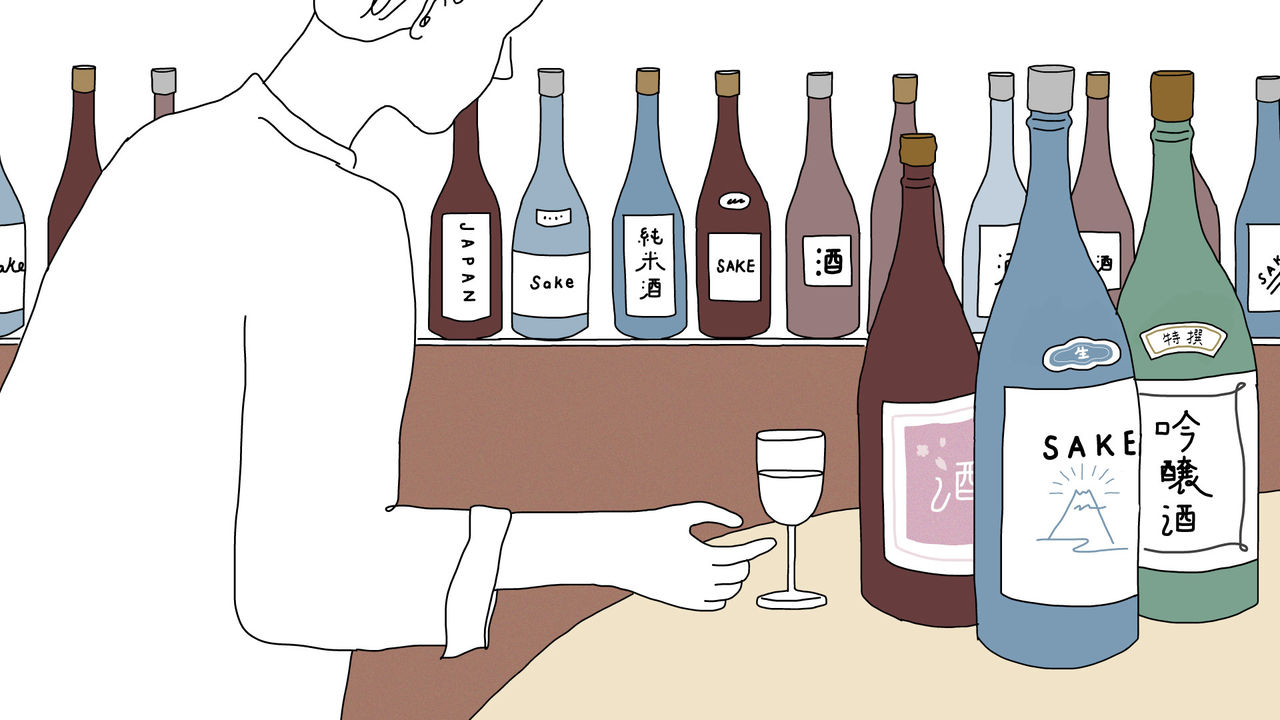
Know Your “Nihonshu”: Let’s Go Sake Shopping
Guideto Japan
Food and Drink Culture- English
- 日本語
- 简体字
- 繁體字
- Français
- Español
- العربية
- Русский
JOE So, I’m going to fly home for a visit during break, and I want to take some nihonshu back with me to give to my dad and a friend of mine. What kinds do you think I should buy?
KAORI I think you should go to my favorite jizake specialty shop and ask the shopkeeper. He knows everything there is to know about nihonshu, so if you explain to him the kind of things you need, he’ll be able to give you some good recommendations. I’d be happy to take you there . . .
JOE Hey, that would be great!
(At the jizake specialty shop)
SHOPKEEPER Kaori-san, nice to see you! I see you’ve brought a friend.
KAORI Meet Joe. He’s a university student, and he’s always trying to learn more about Japanese culture. I’ve been very impressed.
JOE (Blushing) Really?
SHOPKEEPER Nice to meet you, Joe. How can I help you today?
JOE Well, I wanted to buy some sake to take home to my father and a friend of mine.
SHOPKEEPER Omiyage, right? In that case, maybe you’d like something packaged in a box for gift giving, like one of these?
JOE I think my dad would like that. But just the plain bottle will do for my friend. Not those big bottles, though. Something more around the size of a wine bottle, if possible.
SHOPKEEPER That would be a yongōbin, or 720-milliliter bottle. Do you have a price range in mind? The price varies a good deal by designation. For example, for this brand here, the top of the line is the junmai daiginjō at 4,000 yen. The junmai ginjō is 1,800 yen, and the tokubetsu junmai is just 1,300 yen.
JOE That’s less than I thought. But what's the difference between the most and least expensive?
SHOPKEEPER It mostly comes down to the variety of rice and how highly polished the rice is—the seimai buai. The most expensive sake isn’t necessarily the best. If you know how much you want to spend, we can look for something suitable in that price range.
JOE I had in mind around 1,500 yen for my friend and maybe around 2,000 yen for my dad.
SHOPKEEPER Okay, let’s start with your friend. Do you know what kind of food he likes?
JOE Well, lately he’s become a big fan of sushi. There’s a new restaurant in town that serves sushi, and he says he orders a lot of takeout from there.
SHOPKEEPER If you’re looking for something that pairs well with sushi, I have an excellent tokubetsu junmai-shu that you can sample if you like.
JOE That would be great!
Regional Differences
SHOPKEEPER Here you go. Kaori-san?
KAORI Of course!
JOE Mmm. It’s quite dry, isn’t it? Very light and clean . . .
KAORI Yes, very. It goes down easily enough. But . . . well, it doesn’t have much impact by itself, does it?
SHOPKEEPER Exactly. Not much aroma, either. That’s what makes it such a good accompaniment for sushi. A fruity sake or one with a lot of umami can clash with or overwhelm the flavor of raw fish. This particular sake brewery is located on the coast, in an area famous for its fishing industry, and its sake naturally pairs well with sashimi. For fresh seafood, you can’t go wrong with this brand.
KAORI I guess it makes sense that a particular region would produce a nihonshu that complements its own food.
JOE I like the calligraphy on the label, too. I think this would make a good present for my friend. But I’m wondering, is there sake that goes well with meat? I’m kind of a carnivore myself . . .
SHOPKEEPER Here, give this junmai-shu a try. It has more body and umami. This brewery is located inland in a mountainous region, where the traditional diet includes wild game and various preserved foods. So, the sake is made to stand up to stronger flavors.
JOE Mmm, I like it! I’ll take a bottle of this for myself.
Sake for Wine Lovers
SHOPKEEPER Now let’s see if we can find something for your father. Is he familiar with sake?
JOE Not very. I think he mostly drinks white wine. Chardonnay and that kind of thing.
SHOPKEEPER Well, in that case, he might like this junmai ginjō. It usually appeals to people who are fond of the French whites. Here, give it a try.
JOE It does have a fruity fragrance. It’s got body, too, but a nice clean finish. And something else that reminds me of wine. Almost like a hint of salt or something . . .
SHOPKEEPER That’s a very astute observation!
KAORI I told you, he’s a good student!
SHOPKEEPER What you’re tasting is the mineral content of the water used in the brewing process. Most areas of Japan have soft water, but the water used by this particular brewery has a relatively high mineral content. That sort of mineral taste is something white wine lovers are quite at home with.
KAORI It also has a slight acidity, which should complement things like meat and cheese.
JOE Okay, that settles it. I’m sure my dad is going to like this.
KAORI Hurray! I’m glad I came along. I only wish I could tag along and meet your father, too!
JOE (Blushing) G-gee, you mean it Kaori?
SHOPKEEPER (Beaming benevolently) Well, then, is there anything else I can do for you two today?
KAORI I think we’re all set.
JOE This has been one of the best shopping expeditions ever. Thanks so much for all your help!
SHOPKEEPER It’s been my pleasure. Next time, you can tell me a little more about your own preferences, and we’ll match you up with a sake to suit your tastes and budget. Matchmaking is what jizake specialty shops are all about.
JOE Oh, I’ll be back! We’ll back. Right, Kaori?
(Originally published in Japanese. Banner and illustration by moeko)
- “Nihonshu” Now : Behind the Global Sake Renaissance
- Know Your “Nihonshu”: Understanding Sake Brewing
- Know Your “Nihonshu”: Types of Sake and Their Characteristics
- Know Your “Nihonshu”: Sake Tasting Demystified
- “Nihonshu” Now: Yamagata and the Sake Renaissance
- Know Your “Nihonshu”: Sake Wisdom for Guilt-Free Drinking
- “Nihonshu” Now: Japanese Brewery Senkin Rewrites the Sake Rulebook
- Know Your “Nihonshu”: The Many Faces of Sparkling Sake
- “Nihonshu” Now: Adventures in Creative Sake Pairing
- Know Your “Nihonshu”: How Serving Temperature Affects Flavor
- “Nihonshu” Now: How the Maker of Jikon Turned Mold Into Gold
- Know Your “Nihonshu”: Drinking and Serving Vessels
- “Nihonshu” Now: “Jizake” Boutiques Make Sake Shopping Fun
